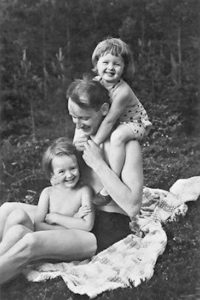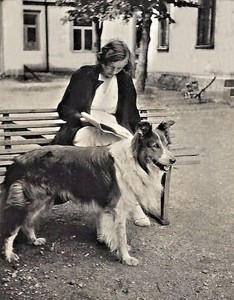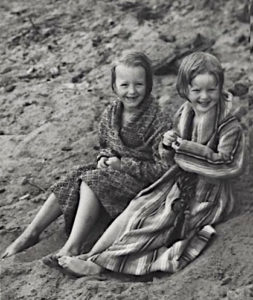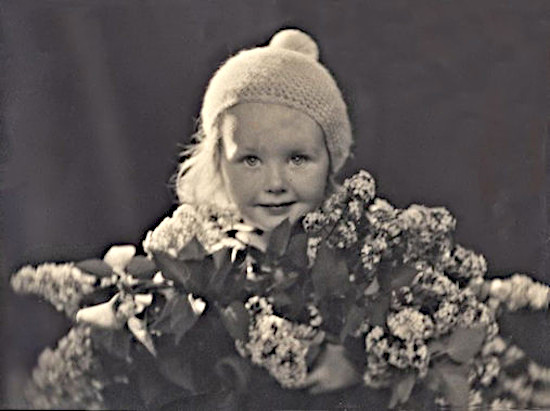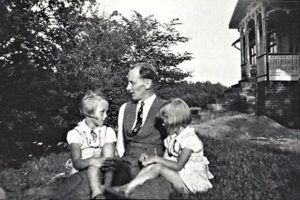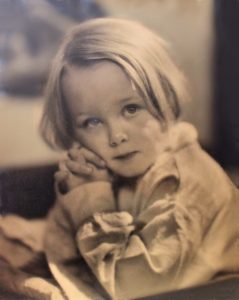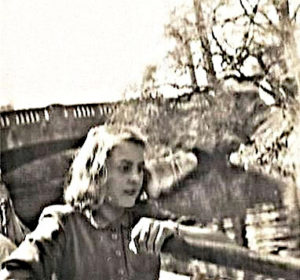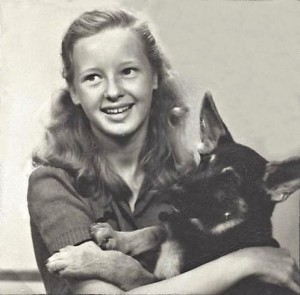Oscar and Bertha had three children, two sons and a daughter, who was my mother, Magda. My grandfather did not believe much in formal education, but in Mother’s case, she got the last word. Grandpa thought that if you were intelligent and talented, you would make your way to a successful career anyway. Which is in fact what all three children eventually did
Magda, however, was too strong-minded not to get her own way. She was also her father’s’ favorite child and thus she won. So off she went to secondary school in a nearby town. As she started studying German, Grandpa studied it with her and that’s the way he got to know a bit of a foreign language. Magda had been stubborn when it came to traveling to another town to be able to go to secondary school, but after a few years she got fed up with school and with home – for some reason that will always be a mystery to all of us. She dropped out of secondary school.
Mother wanted to become a photographer, like an uncle who was one of the very few people who had received a gold medal from the Swedish Photographers’ Association. This uncle, Jacob Sörner, lived in a city called Borås, in the province of Västergötland, not far from Göteborg. She was welcomed in his home and became like a daughter to the couple, Jacob and Alma. They also had a son, Ryno, who was much younger than Magda. It is not quite clear to me how she became so proficient, but I do know that she also studied photography with one of the very best photographers in Sweden, Edvard Welinder in Stockholm. I learned from a friend’s encyclopedia about people, famous people, that it was Edvard Welinder who had introduced the style of light backgrounds, and I then understood where Mother had got that idea from. She was adamant about light backgrounds and much light in general. Later on it was Mother who became the one who taught photography to other young photographers from all over Sweden. We were all proud of her – and she was the prima donna!
We lived in Vaggeryd for several happy years, and that is where I was born. But — Mother decided she wanted a larger arena for her photography. So, later, when I was five, she and Pappa agreed on leaving Vaggeryd, a small town in Småland, for the big city of Malmö. This meant moving to Skåne, all the way in southernmost Sweden, to a city neither one of them really knew. But Mother was fearless and pappa certainly thought he would be able to get a good job as an accountant in Malmö too. Which he did. Malmö is situated right across the Sound, Öresund, from Copenhagen.
Mother’s grandmother Lovisa was dubious and said “Wouldn’t you rather be the first one in Vaggeryd than the last one in Malmö?” Mother quipped, typically: “I’d rather be the first one in Malmö.”
She became a top photographer with medals galore from the Swedish Photographers’ Association (Svenska Fotogrfafers Förbund, SFF)
She actually got to be at the very top in Sweden, in her generation at least. She also became the theater photographer very soon after the opening of our new and imposing theater in Malmö, Malmö Stadsteater.1. This was the beginning of a new era for both Gun and me. Ever since Malmö Stadsteater theater has been a major part of my life. I feel that I grew up with theater in my blood.
_____________________
But let’s get back to Småland and my very young childhood. Mother had many fun ideas. Once, when we were still living in Vaggeryd, she planned a party for us and our friends where we would all be dressed up as flowers, each one a different one. I can vividly see my young girlish-looking mother kneeling on the floor surrounded by rolls of crepe paper in different beautiful colors from light mauve and purple to yellowish green.
Flowers were always part of Mother’s world, as much as animals of all kinds, nature in all its forms. When I was a baby we had a collie dog whose name was Pojken (= the boy). Mother told me much later how he would guard me, sitting between me and the fire in the rooms with the old-fashioned tiled fireplaces we had in every room in Vaggeryd – beautiful things, always standing high in a corner of the room. And Pojken would also sit between me and the water if we were out on a dock.
When we lived in Vaggeryd we used to go swimming in a lake called Hjortsjön. It was not far away but we had to be accompanied by a grown-up.
I guess it was usually wonderful Svea, our housekeeper, who took care of us and everything , who came with us. But sometimes it was Mother, and then she would bring along a camera and take pictures of us. Also on the rare occasions when Pappa too was at the lake, a couple of wonderful pictures were taken.
Oh, those were happy days!
Intermezzo
I came out of the water, lips shivering with cold from the lake water. Mother was on the beach holding out my bathrobe, kneeling in the sand. I ran towards her laughing throwing myself into her arms and being wrapped up snugly in the yellow robe, being rubbed warm by Mother. She was smiling happily, and there was nothing but love and warmth..
____________________
We had cats and dogs at various times, but Mother didn’t stop there. In my home there were as many animals, at different times, as you could possibly get into an apartment.
Biking back from work one day she found two little white mice in a gutter. They had clearly escaped from a circus that had just left from a nearby site. She somehow managed to get them home and we had two white mice at home for quite some time. Sooner or later a mouse was bound to be stepped on by someone, however, and that’s just what happened. Their saga was rather short.
One day Mother somehow found a squirrel. He was probably a bit lame since she managed to catch him. Well, he recovered and he would climb up and down on our curtains and appear where we least expected him.
There are problems with small animals that run all over the place, as anyone can understand, and we were cleaning up little pellets all the time. The end of the squirrel was sad. Pappa came back from work one day and threw his heavy briefcase on the big bed. He of course had no idea that the squirrel was peacefully sleeping under the bed-covers. A very sad ending for a cute little squirrel.
We had very cute little hamsters, Mother had a pair of pretty yellow birds in a cage who did not sing, and we had gorgeous fish swimming around in the huge aquarium in Mother’s room.
For an evening we even had a hedgehog. I have no idea how Mother managed to pick it up or get it back to his natural habitat. We gave him milk which he lapped up and then noisily click-clicked across the parquet in the living room. We put him back out the very same evening, I am sure.
Mother also used to tell us about how she tamed fish to eat out of her hand when she was a child. Some fish I am sure would willingly come up to the surface and eat food that was offered, if it was the right kind, maybe a worm.
Some of Mother’s ideas for domestic animals were not very good. Even the hamsters somehow got out of their cage once in a while and one day we found that our Stora kokboken (“The big cookbook”) had quite a bit of one corner chewed up. It was time for a new cookbook anyway, so not a big deal. It was a bit of a mess, however, cleaning up all the tiny pieces of paper left behind their gnawing. They had managed to get into a kitchen drawer from behind. I have seen cows in the streets in India happily munching on a piece of cardboard, but our hamsters were well fed and were just having fun.
Mother was indeed a character and she never did things the way other mothers did. When she cooked… which was not very often since she worked hard in her photography business and we of course had to have a maid, But when Mother cooked it was always delicious. I still remember things she prepared — and some dishes that were quite complicated — that I know I will never taste the equal of ever again.
Intermezzo
It was a warm summer day in Småland and we were out playing in front of our house. I was four or five years old. Suddenly we saw the ice-cream man turn the corner and heard his little bell ringing. He kept his ice-cream in a cart with very special insulation and where lids opened at the top. He only came by in the summer and in those days there was no ice-cream except during the warm season. And there was only one flavor, vanilla. But what else could you wish for when you could get the best vanilla ice-cream that was ever made by man? It was heavenly.
We ran as fast as we could to Mother to tell her the ice-cream man had arrived. She gave us each a big copper 5-öre piece to buy two cones. I took a lick with the deepest pleasure a delicious-tasting ice-cream cone can possibly give. I was so happy I started laughing and dancing and, I didn’t know how it happened, but suddenly my ice-cream was lying in the sand. All I had left was the cone I was holding in my hand. The heavenly ice-cream was melting fast, running out in little rivulets in the warm sand. Tears, oh tears!
__________________
For the flower party we had in Vaggeryd, I believe she made the costumes for all the kids, our closest friends of course. There were John and Ingrid, the doctor’s children, our best friends in school and kindergarten, Margaret, the butcher’s daughter, a bit chubby, as behooves a butcher’s daughter, and cute little Allan, who was always the smallest one of us all and always impeccably dressed, with a tie and well pressed pants. And Marianne and Margit who lived upstairs from us were not forgotten. Our apartment and Mother’s photography work rooms were on the second floor. The store and the studio were on the ground floor. This little Allan is in several photos from those cloudless days and also in the 8mm movie Mother took on my fifth birthday, my last birthday in Vaggeryd. That summer we moved to Malmö.
The floor was covered with rolls of crêpe paper in beautiful colors. She cut out and sewed or stapled together all the costumes for the flower party. Gun was an orobus tuberosus, a mauve flower of the leguminocae family that we call gökärt (cuckoo flower), a pea flower. I believe it has many different names even in Swedish. That was Gun’s favorite flower at the time. I was a primula veris, of the primulacae family, gullviva, cowslip in English. Gun’s costume was gorgeous in its mauve coloring. Mine was yellow and light green of course.
Mother taught us Latin names for flowers even before I started going to school. I have never lost my great love for flowers and I still today know a whole lot of flowers by their Latin names.
Of course, Carl Linnaeus, the great botanist and founder of taxonomy was Swedish.2 We Swedes call him Carl von Linné — but he is usually Carl Linnaeus in other countries. I don’t think many children were taught botany by their mothers at an early age, if at all.
Obviously since I went to school in Sweden, I later got to learn a lot more about botany — families, classes and many more Latin names of individual flowers. In fact, in what would be junior high school in the U.S. we had to collect a minimum of 50 flowers, press them in a specially-bought heavy wooden press with a screw-on solid top where you carefully pressed the flowers between big heavy dark gray sheets of blotting paper so roots and leaves and petals were all visible. We then taped them up in what was called a herbarium. We had to learn all the names, in Swedish and Latin, the families and the class of each one of them. I remember I had 60 flowers in my collection. I didn’t want to be too far behind my best buddy at the time, wonderful unforgettable Aina, who had 90 flowers. I was very impressed.
Aina
Aina was a poem. She was blond with somewhat curly hair. Her parents were divorced, like mine. I did meet her father once when they lived in an apartment in the big building of the fertilizer factory where he was probably the CEO or head engineer. It was Aina’s birthday party, ten years maybe. When the party was over, her parents accompanied us over a huge metal bridge that spanned the entire mass of rails that went to Malmö Central Station. Aina’s parents probably took us to where we could get on streetcars and buses.
Aina had had an older sister, called Maja, who was always spoken of as if she were an angel. She died in her young age. I never felt like asking of what.
Aina’s parents got divorced and towards the end of grade school, Aina and her mother moved to a small apartment on the last floor of an old but high-class apartment building, with a terribly slow and noisy elevator. It was very close to our new school and Aina and I spent many fun afternoons in their apartment. There was an attic space next to the kitchen that used to be all empty and had a very low ceiling and no windows. One day there was a bed in there. Aina said it was for a friend of her mother’s and we giggled. We never talked about it again and it was all very hush hush.
Aina was always a lot of fun. Always new fun ideas and fun stories that she probably made up. About her aunt who came back from America, about her grandmother’s senility and generally about events in her life. She had the most amazing imagination.
One fun little thing we did was getting little pins, all metal and putting them on the tracks of a streetcar. When the streetcar had passed over it, the pin had become a delicate flat little sword, which we pinned on our lapels. When I think of her as a little girl I see her in a light blue dress with a little collar. I must have seen her in that dress quite a few times.
We had a hobby of renting a rowboat and rowing around on the canals and under the bridges that surround the old town of Malmö. I must have had my sister Gun’s box camera with me this time since I took the only photo I have of Aina. And it is not a good one, but it more or less shows what she looked like. She was a very pretty girl.
She was very good at Swedish essay writing. And once, in grade school, she wrote little verses about her closest friends, probably for a party that I have forgotten about. However, I still remember the verses about me and about our friend Ragnhild.
Just in case someone ever reads this who knows Swedish, here is the verse about me that I think was very funny, funny rhymes and fun made-up words. I didn’t actually have long curls, as she says, but rhyme oblige. She says I made no mistakes in spelling, but I do remember that I had one mistake one year. I think I had spelled kam (comb) with a double m. And she says I’m afraid of the dark, which I was, but the fun thing is the way she made up the word for the dark, as if it were a spirit, and made up to rhyme with kvällen, the evening. Actually, I didn’t dare go out in the evenings, after dark.
Siv har så långa lockar, hå hå ja ja
i rättstavning inga bockar, hå hå ja ja
Hon rädd är för mörkepellen, hå hå ja ja
och vågar ej gå ut på kvällen, hå hå ja ja
(to be sung of course to a fun melody)
I also now suddenly remember how we had a serious crush on James Mason, Captain Nemo in “20,000 Leagues Under the Sea”, his wonderful voice probably standing out particularly in our adoration of this man — who never knew that two little school girls in Sweden were enamored with him. I don’t remember any particular movies we saw with James Mason, but I do remember that once we went all the way down to Limhamn — streetcar no. 4 — to see one of his movies where a wicked woman slapped him over his knuckles when he got something wrong in his piano playing. My heart bled for him.
Aina had a piano, which saved me when in our music class we had to learn to play a short melody, even if we didn’t get the fingering right. I managed to get my 10 points without the silver star since my rhythm was not right.
Aina missed our first reunion in 1962, after I had just done my student teaching at Statens Normalskola in Stockholm. She did, however write a vert funny letter which Karin Lindholm read out for us, and it was greatly appreciated. Thirty years later in 1992, my very dear friend Britt in Täby, Stockholm, had a mini reunion in her home. That was when I first saw Aina since a meeting at our old grade school teacher’s, Anna Borgström’s, home in 1953, a wonderful teacher, to whom we owed a lot.
Our next reunion wasn’t until 2002, a big event organized by Karin and Britt. Fifty years. Wow! I did recognize most of the old ladies though. But Aina wasn’t there. Britt had let me know that Aina died of lung cancer in the late nineties. Aina, Aina, how could this little girl so full of life and laughter ever die? But, my dear Aina, you will always be alive to me. She had five children and 15 grandchildren in 1992 and she easily took the prize for those numbers.
But let me make a jump back to our school days, to botany and flower collecting. The minimum required was 50, but Aina had 90 plants. We were of course tested too. So she had to learn all the details about those 90 plants. I guess our biology teacher, Mrs Matton-Lindblad, checked us on ten or so flowers and then said Enough. But Aina must have had quite a job learning the Latin names and families of all her 90 flowers.
We were taught botany one year, zoology the next and the human body the year after that. I was the assistant to Matton, as we usually called her, the year we did the human body and I’ll never forget when she said, Siv, get the bone-man please (out from a back room where there were lots of material for biology teaching). It was a complete skeleton of a man, but certainly not a real one.
After that year there was Gymnasium and Latin and no more time for biology. But my love of flowers and animals and all aspects of nature would always stay with me, certainly imbued in me much more because of Mother than from the compulsory learning of the Linnaeus system in school.
Continued: Chapter 1 (Part 3) The Paradise of my Childhood



